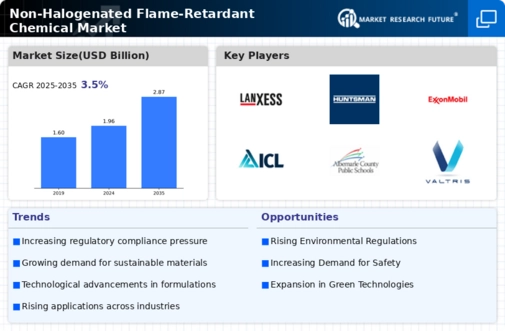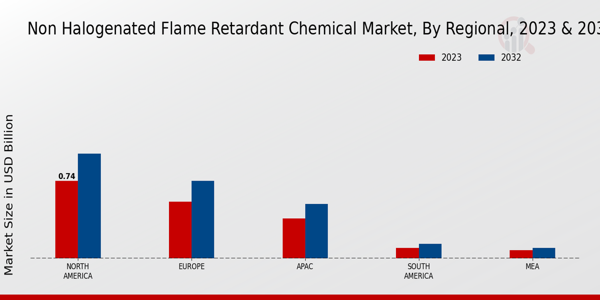Growth in End-Use Industries
The Non-Halogenated Flame-Retardant Chemical Market is benefiting from the growth of various end-use industries, including construction, automotive, and electronics. As these sectors expand, the demand for flame retardant materials is increasing, particularly those that are non-halogenated. In the construction industry, for instance, the rising focus on fire safety standards is driving the adoption of non-halogenated flame retardants in building materials. Similarly, the automotive sector is increasingly incorporating these chemicals into interior components to enhance fire safety. Market analysis suggests that the construction and automotive industries will continue to be key drivers of growth for non-halogenated flame retardants in the coming years.
Stringent Regulatory Frameworks
The Non-Halogenated Flame-Retardant Chemical Market is significantly influenced by stringent regulatory frameworks aimed at reducing hazardous substances in consumer products. Governments and regulatory bodies are increasingly implementing policies that restrict the use of halogenated flame retardants due to their potential environmental and health risks. This regulatory pressure is pushing manufacturers to seek safer alternatives, thereby boosting the demand for non-halogenated flame retardants. For example, the European Union's REACH regulation has prompted many companies to reformulate their products to comply with safety standards. As a result, the market for non-halogenated flame retardants is expected to expand as industries adapt to these regulations.
Consumer Awareness and Safety Concerns
Consumer awareness regarding health and safety issues related to flame retardants is a significant driver for the Non-Halogenated Flame-Retardant Chemical Market. As information about the potential dangers of halogenated flame retardants becomes more widespread, consumers are demanding safer alternatives. This shift in consumer preference is prompting manufacturers to invest in non-halogenated options that align with safety standards and consumer expectations. Market trends indicate that products marketed as free from harmful chemicals are gaining traction, particularly in sectors such as home furnishings and electronics. Consequently, the increasing consumer focus on safety is likely to propel the growth of the non-halogenated flame-retardant market.
Increasing Demand for Eco-Friendly Products
The Non-Halogenated Flame-Retardant Chemical Market is experiencing a notable shift towards eco-friendly products. As consumers and manufacturers alike become more environmentally conscious, the demand for non-halogenated flame retardants is on the rise. These chemicals are perceived as safer alternatives to traditional halogenated flame retardants, which have been associated with various health and environmental concerns. Market data indicates that the demand for non-halogenated options is projected to grow at a compound annual growth rate of approximately 6% over the next five years. This trend is likely driven by the increasing adoption of stringent environmental regulations and the growing preference for sustainable materials in industries such as construction, automotive, and electronics.
Technological Innovations in Flame Retardants
Technological advancements play a crucial role in shaping the Non-Halogenated Flame-Retardant Chemical Market. Innovations in chemical formulations and processing techniques are leading to the development of more effective and efficient flame retardants. For instance, the introduction of new polymer blends and additives enhances the performance of non-halogenated flame retardants, making them more appealing to manufacturers. Furthermore, research and development efforts are focused on improving the thermal stability and compatibility of these chemicals with various substrates. As a result, the market is witnessing an influx of novel products that meet the evolving needs of end-users, thereby driving growth in the industry.


















Leave a Comment